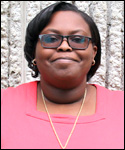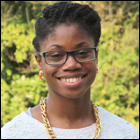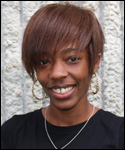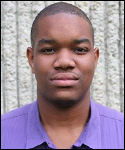|
 |
 |
|
 |
| ECSU URE/REU Summer 2015 Internships |
|
|
 |
 |

Jessica Hathaway
JR-MATH
hathawayjessica18@gmail.com |
NASA Langley Research Center Student Volunteer Research Summer Experience
Mentor: Dr. Gamaliel "Dan" Cherry
NASA
Abstract
My name is Jessica Hathaway and I am a senior majoring in Mathematics at Elizabeth City State University, in Elizabeth City, NC. This summer, I was a student volunteer at NASA Langley Research Center (LARC) (Hampton, VA) in the Office of Education. As part of my volunteer experience, I had the opportunity to work with Katrina Young and Dr. Gamaliel “Dan” Cherry. The two main projects that I participated on were NASA LARC’s Day of Education and YOUth Day. I also had training on how to conduct hands-on science, technology, engineering, and mathematics (STEM) activities with K – 12 educators and students using NASA’s Rockets to Race Cars program. As an education major, this experience opens a door to show different activities that can be used in and out of the classroom.
LARC’s Day of Education is a program that allows LARC employees to volunteer their time and expertise to talk with students about the value of education in science, technology, engineering, mathematics and many other fields. If invited to do so, they may also discuss their work and answer questions about NASA’s mission in aeronautics, exploration, and science. Part of my project for Day of Education was to identify potential partners and companies that offer programs like and/or similar to Day of Education and to collect data about surrounding school systems. Day of Education is a chance for K – 12 students and teachers to learn more about NASA and see that there is more to its inner workings. Day of Education is a way to enhance communication among educators and community leaders.
My next project was LARC’s YOUth Day, it is a one day event that allows NASA employees to bring their youth (i.e., family members and friends aged 5 – 17 years old) to the Center in order to spend a day touring NASA facilities and participating in educational activities in the Integrated Engineering Services Building with other youth. YOUth Day is a way to inform youth about NASA and encourage them to pass on what they have learned to others during their school year. My responsibilities include getting the word out about the event through internal communications using web-based @LaRC advertisements. This is an online tool to post information about what is happening, when and where. This is also how we gave out information to request staff and students to volunteer their time as a tour host, information booth helper and greeter/host. I also created a PowerPoint Presentation that was used to share logistical information with all volunteers who are participating in the event. Along with maintaining the exhibitor and volunteer list and schedule and review it with Katrina on an ongoing basis. Lastly, I prepare materials that were to be handed out to the youth day participants during the event.
I have also had the chance to participate in training and train others using activities that are part of the NASA Rockets to Race Cars program and special events with NASACAR driver Jimmie Johnson. Rockets to Race Cars is an education program for students and teachers that helps them to understand the science of NASCAR racing as it relates to NASA research by participating in STEM activities that help students to gain a better understanding of the forces of flight, physics of motion, and learn how these forces allow planes to fly in the air, and hold racecars tight to the track at amazing speeds. For example, an activity that was done during training was Drag Race to Mars, an Engineering Design Challenge. The purpose of this challenge is to design a capsule to land on Mars just as NASA engineers have. As the capsule rushes through the atmosphere it is speeding towards the surface headed for a crash landing. You need to use the drag of the atmosphere to slow the capsule down. Using the materials described, design an apparatus that will create enough drag to allow the capsule to have a soft landing on the surface. For more information about the challenge see the link: http://www.nasa.gov/offices/education/programs/national/dln/special/R2R_Ed_Res.html#.VYfJb1Jy3Sg.
This internship has taught me that there are more STEM-focused activities that can be done outside the classroom. This is a chance for educators to have a better understanding of NASA as well as myself. |
|

Nigel Pugh
JR - CS
migel.pugh32@gmail.com
Poster PPT / JPG |
Exploration of Mobile Testing Through Automatic Test Case Generation
Mentor: Dr. Renee Bryce, Ryan Michaels
University of North Texas
Abstract
As technology continues to progress and become a more integral part of everyday life, the need for efficient and reliable testing services likewise continues to grow. This is especially true in mobile testing, where there is both incredible device diversity and a low barrier for entry into the realm of application creation. Most current mobile research has focused on either addressing concern over applications functioning over a wide range of devices, or proof of concept test generation on no more than a handful of applications, and typically cannot be generalized to a wider application pool. This summer we have focused on addressing that second issue, by developing a tool for test case generation of android applications regardless of android version and emulator type. Additionally, the team explored the breadth of the software testing process, from application discovery, test case generation, replaying of test cases against bugged versions of the application, and finally exploring questions of test case analysis, specifically looking at (GUI) element coverage. |
|

Tatyana Matthews
JR - CS
tzmatthews849@students.ecsu.edu
Poster PDF / JPG |
Investigating the Security Risks and Vulnerabilities of an Android System
Mentor: XiaoFeng Wang, Ph.D., (Graduate Mentor) Kan Yuan
Indiana University Bloomington
Abstract
Android System is a mobile open-source operating system (OS), developed by Google, utilized by a large community of users from around the globe [1]. Due to its free and vast ecosystem, users with good intentions as well as criminals have taken advantage of the OS, unfortunately, implementing malicious attacks on many of Android's vulnerable applications [2]. Because of security risks and exposures facing Android OS, the primary concern has been exploring methods that enable Android to remain open-source and sustain a high level of security. As a result, this research investigates the recent vulnerabilities and security risks of Android System, in addition, utilizes one of vulnerabilities explored (CVE-2014-3500) to design and conduct an attack via application on Android mobile device. Essentially, this study will produce familiarity with how Android System security is approached and operated to keep the operating system secure for its users. |
|

Tori Wilbon
JR - CS
toriwilbon@yahoo.com
Poster PPT / JPG |
Exploring Learning Algorithms for Layer Identification
Mentor: Dr. Geoffrey Fox, (Graduate Mentor) Jerome Mitchell
Indiana University Bloomington
Abstract
The focus of this project is to explore learning algorithms for automatically detecting layer boundaries from images collected from the Polar Regions, specifically Antarctica images. . Layer boundaries are incorporated into climate models for forecasting a rise in sea level but are difficult to extract from noisy images. Currently, glaciologists manually identify layer boundaries, which is time-consuming and requires sparse hand selection. An active contours model will be explored for detecting layer boundaries. An active contours model (snake) is used in computer vision for object tracking, shape recognition, segmentation, and edge detection. The snake algorithm is an energy optimization spline guided by an outside constraint force and influenced by image forces, which would pull it toward layer boundaries. |
|

Jefferson Ridgeway IV
JR - CS - ECSU
jdridgeway78@students.ecsu.edu
|
Regression Testing Selection for Android Applications
Mentor: Dr. Guowei Yang
Texas State University
Abstract
Android is a widely used mobile platform for which many applications are developed. During the development process, many modifications are made resulting in potential changes in old behaviors and the introduction of new behaviors. Therefore, ensuring the reliability of applications is highly desirable. However, traditional regression testing techniques cannot be directly applied to the Android domain due to its differing architecture. To better understand how to develop and improve upon regression testing techniques, we first conducted a bug study focusing on bugs related to change. Then, we performed a change impact analysis on selected applications to understand the potential effect changes in the Android library and in the Activity component could have on the rest of the application. We believe that this study will help developing new or improving upon existing regression testing techniques specific to the Android domain. |
|

Derek Morris
JR - CS - ECSU
dmow4454@gmail.com
|
NASA Langley Research Center Student Volunteer Research Summer Experience
Mentor: Dr. Gamaliel "Dan" Cherry
NASA
Abstract
My name is Derek Morris Jr. I am a student at Elizabeth City State University, in Elizabeth City, NC. This upcoming year I will be a senior majoring in Computer Science minor in Mathematics. This summer I was a student volunteer at National Aeronautics and Space Administration (NASA Langley) in the Studio Production. In this internship, I had the opportunity to work with Dr. Gamaliel “Dan” Cherry Glenn, Sweat, and Katrina Young. The projects I took part in were equipment’s and schematic, and YOUth Day. There was also training in the workshop Rockets to Race Cars.
One of my projects was to install equipment racks in a new building. The purpose of the racks was to keep the electronic equipment from overheating. The equipment track was meant for a new tri-caster system purchased by Dr. Cherry. The tri-caster is designed to put any background you want when you in a video conference as long as you have a green wall behind you. The tri-caster serves as a recorder and video switching unit.
The next step was to run cabling through the floors. Before the cables were run, the length of the room had to be measured in order to assure that slack would be available. The cable was run through the floor because it was much cleaner and would not pose a tripping hazard. The next part of the project I worked on was the talk back system. The talk back system is used as a communication link between the control room and the announcer. This allows them to communicate with each other to work out sound issues and the view of the cameras. The system was inoperative when we began. We found that one of the wires had a low signal. It was repaired by removing a portion of the wire reducing the distance that the signal had to travel.
After the completion of the talk back, I then started to work on the schematic for studio B. This schematic was a wiring design for the room showing connections between the equipment. For example: The tri-caster is going into the computer and out a monitor.
The next project was YOUth Day. This is a day that NASA employees bring their youth to the base and spend a day touring and getting an opportunity to participate in activities’ on the base with other youth. Part of the project was to get word out through the Langley Research Center (LaRC) advertisements. This is a place to put out information about what is happening, when and where. This was how we gave out information to let the staff and students know how to volunteer their time with tour hosts, information booths, and as greeters/hosts. YOUth Day is a way to inform the youth about NASA. They then pass on what they have learned to others during the school year.
I also had the opportunity to work with some preparation in Rockets to Race. Rockets to Race helps the understanding of the art of science with racing, through taking part in in exercises to help students to pick up a better comprehension of the powers of flight and movement, and figure out how these powers lift planes into the air, and hold racecars tight to the track at astonishing velocities. This was all being done by working with NASCAR driver Jimmie Johnson.
An activity that was done in training was Drag Race to Mars Engineering Design Challenge. The purpose of this challenge is to design a capsule to land on Mars, just as NASA engineers have. As the capsule rushes through the atmosphere, it is speeding towards the surface, headed for a crash landing. Students need to use the drag of the atmosphere to slow the capsule down. Using the materials described, they design an apparatus that will create enough drag to allow the capsule to have a soft landing on the surface.
This internship has shown that there your major can be used in a lot of different ways. NASA has proven to me that you will have to be a well-rounded person to work there. This internship will give all majors a better understanding about what they want to do with their future. |
|
|
| |
|
| |
|
 |
 |
 |
|
 |
Elizabeth City State University does not endorse, sponsor or provide material located on this site. |
| |
|

